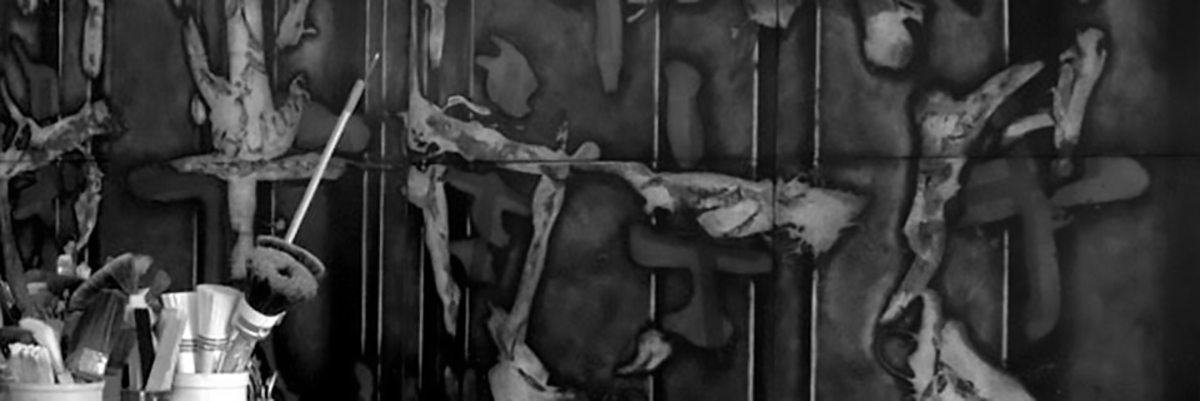
ORIGINAL SIN
Mark Rodriguez’s dark and visually elusive, yet intensely illuminated and inspirational art works represent a profound investigation of deep observations in the nature of the world and humanity that surrounds him. Exploring how abstracted forms and shapes dissolve and coagulate, how shapes form and melt, how they disband and reassemble, his work evinces a style that is reminiscent of a broad range of influences from Northern European Medieval alter paintings and Gothic stained glass, to the muscularity of Neo-Expressionism. The sensuality of his sense of light is perhaps most evocative of Caravaggio. Despite these classical influences, abstraction is the vocabulary he relies on to depict the links between the representational and the abstract. Relying on a variety of media including painting, sculpture, and intermedia, he celebrates form and light through highly innovative approaches and techniques. Straddling the line between politics and spirituality, these works carry open-ended meanings that can be interpreted in a variety of ways. Trusting in his intuition, his practice is a mystical and enigmatic expression. His work provides glimpses of insight into his own subtle and sensitive perceptions of the world around him. Letting the work guide him as he goes, he explains: “I only know I will begin a piece and I know that I have the experience, the ability, and the faith to someday finish it. The rest is an adventure. I can’t tell you what it’s all about. The rest is left up to the viewer to interpret given the clues he leaves behind in his creative process.” While his work may at first appear ominous and foreboding, his entire oeuvre from his paintings to his installations reveal profound insights into the paradoxes of life. Like microscopic cellular imaging, he presents us with a reality that can be seen only indistinctly, as if through the fog of a Surreal dream. As if in flux, these fragile images, clearly finding their point of departure in natural forms, appear web like, networked, and tenuous, like root structures sprouting and growing infinitely. Take for instance, Portolan Chart, an intensely glowing image of vertically striated browns, greens, blacks, and brilliant golds. Appearing as if illuminated from within, the long bars of earth-tone hues, his signature palette, appears like shining mystical trees growing in a dense forest within which rays of sharp sunlight penetrate through the branches. In a similarly executed, and equally compelling work, Spanish Map, a gridded image composed of a series of small square canvases clustered together to create a larger composition on which we are presented with floating organic forms in warm earth tones on olive greens, with a repeating motif of what appears to be a red cross. Storm Triptych, a profound and deeply compelling series of three canvases depicting hovering molecule-like ovules in murky grounds of crimsons and olive greens, again achieves its strength of expression through its intense sense of interior illumination. While far from the bright colors, irony and surfacey conceptual distance of Pop art, these paintings are still quite reminiscent of the graphic work of art duo, Gilbert and George. Like their work, his stark and moving images have a graphic power that is flatly presented on surface of the canvas, resulting in imagery that is both forceful and spellbinding. While his paintings tend more toward the abstract, his sculptural work tends more towards the figurative. In Americana, for example, an installation depicting a quasi-representational series of headless human figures arranged in a line with light bulbs suspended over the headless corpses implies a direct political critique of the state of the nation and cultural direction. The theme of the human body is again used in Attention Given to Something, a series of modeled wood arms suspended from the wall with empty wooden picture frames attached to the upper arm of each. Again, another challenge to the unquestioned religious dominance in our country. cruciFiction, an agile play on words, is the title of another thought-provoking installation consisting of a clustered arrangement of large books arranged on the gallery floor and pierced with large railroad ties. Literally crucifying fiction the vocabulary of this work references a range of ideological sources including the American history of book burnings and witch burnings, touching on political polemics as wide ranging as capital punishment, illiteracy, and censorship. As painter Ross Bleckner has said, “A spiritual search in art is looking for meaning outside of yourself.” This could certainly be true of Rodriguezs work. There is something deeply intense and critical in his personal sensibilities and modalities of expression. He is incessantly searching for meaning and answers, while always profoundly critical of the injustices and hypocrisies he encounters along the way. A keen observer of human behavior, he translates his experiences into concrete material production that can be experienced viscerally and spiritually intuitively by his audiences.
– Suzie Walshe End main
